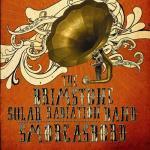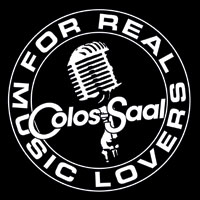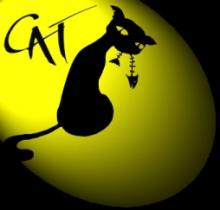Unter das Kapitel “Bands, die aus Norwegen kommen” fallen für den Durchschnittshörer fast nur schwarz-weiß angepinselte Kirchengriller, die zudem auch noch infernalischen Lärm fabrizieren.
Band:
BiografieIt’s a beautiful autumn morning in Bergen, Norway. The sun is shining down from a clear, blue sky. It’s September, it’s Sunday and the citizens of Bergen are preparing to enjoy their day off... The Brimstone Solar Radiation Band
But in one part of the town, the sunlight is obscured by thick, black smoke. A row of old 15th Century shorefront warehouses have been ravaged by fire, and are now reduced to glowing, giant mounds of ash and embers. Plenty of onlookers have gathered to witness the fire-men's desperate struggle to keep the flames from spreading to any nearby buildings.Among these are an extraordinary high number of musicians from the Bergen rock scene, clearly unaccustomed to being awake at such an early hour. The time of day isn't the reason for the pain plainly visible on their faces, however. This comes from the fact that the warehouses housed a great number of rehearsal rooms, almost every musician in Bergen have been through here at some point.
One of the spectators trying to make out blackened guitar-necks, melted amplifiers and wrecked drum-sets among the fumes and debris is Rolf Edvardsen, singer and guitar-player in The Brimstone Solar Radiation Band. He's leaning on a fence, newly risen from sick-bed, peering into the smoky ruins where Brimstone have been rehearsing for many years. To lose the rehearsal-space with all the gear inside have been a nightmarish fantasy for a long time, a final Day of Judgement for the band he has devoted so much time, money and energy. A final hint from Destiny to prove that this project is doomed, the last of the strange accidents and mysterious mishaps that have plagued the band through it's entire lifetime. What can he do but put on a bleak smile? The Universe has given it's clear answer to whether it reckons Brimstone to be viable or not. This is the sign that he has been waiting for, that it's time for a new start, that a change is around the corner, that great things are coming. The day before the fire Brimstone had moved their stuff into a new rehearsal -room, far away from the ravaging flames.
The story of The Brimstone Solar Radiation starts at the tail end of the 90's. After being teenage participants in the infamous Bergen metal scene earlier in the decade (though at a safe distance from church-burnings and stabbings) Rolf Edvardsen and Truls “Biff” Eriksen decide to head down a new musical path. For a brief moment they're considering playing a sort of desert/roadmovie rock inspired by the likes of 16 Horsepower and Nick Cave. The desert is soon left behind, though, and the two head westwards, to the lush and musically fertile hills of the American West Coast. Time is turned back as well, to the halcyon years of the late 60's. Artist like Love, The Byrds and Santana serve as fresh wells of inspiration and creativity. After a while the beautiful, psychedelic and melodic West Coast landscape starts being sprinkled by the power and ambition of British 60's rock (especially bands like Pink Floyd and The Who) and the early Brimstone sound is born.
Rolf and Biff produce several demos, with Biff playing bass and drums and Rolf playing pretty much everything else. Intent on playing live as much as possible, it's obvious from the go that new band-members have to be found. But where? Bergen was hardly awash with psychrock-inclined talent, traditionally being more of a pop/electronica (Kings of Convenience, Röyksopp, Datarock et al.) kinda town. Dozens of auditions were held, but no-one seemed to fit the bill. Finally the two decided to unearth an old friend and previous band-mate, Thomas Grønner. He had played drums with Rolf and Biff in several short-lived metal bands, but had drifted onto the pop scene later on. Heavily influenced by jazz, he had begun to develop a reputation as one of the best drummers in Bergen. After a few sessions in became clear that Thomas was the vitamin shot the band needed, and that his inventive drumming took the band to a whole other level. Thomas was sceptical at first, but the music intrigued him, and after being promised that his only tasks within the band would consist of drumming and drinking beer - and nothing else - he was in. Thomas did not only bring powerhouse drumming to the band, he also brought his brother Øyvind along. Øyvind soon revealed himself as a very talented multi-instrumentalist and joined Brimstone as guitarist, organ-player, backup-singer and percussionist.
With a complete line-up finally in place, Brimstone wasted no time. An old, disused swimming-pool (with outstanding acoustics) at a local children's school served as a rehearsal- space, and the band soon knocked together a killer live set. The set was almost all original material with a few choice covers such as “You're Gonna Miss Me”, “So You Want To Be A Rock N' Roll Star” and “Soul Sacrifice” throw in to please the punters. A few concerts were booked in Bergen and nearby towns. The impact was instant. From the get-go Brimstone was a live band firing on all cylinders. Everyone knew how to play, knew how to sing, the style was clear and defined, the original material outstanding, the members of the band brimming with enthusiasm. Soon Brimstone-concerts became happenings, gigs in crowded smoky, steamy basements, psychedelic lights a- flashing, psychedelic waffles served Merry Pranksters-style, the band resplendent in Day-Glo kaftans onstage, with wiry, groovy, tuneful music dripping from their fingers seemingly without effort. Each one of these early gigs ended with a storming version of “Soul Sacrifice” ,the sight and sound of Øyvind beating the hell out of his congas a surefire way to bring the house down.
Buoyed by the phenomenal reception given them, Brimstone headed for the studio with the ambition to a record an EP that would land them some nationwide gigs. The undertaking proved to be a huge success. Parring dynamic- Who like rockers like “Hangover Sunday” with intense psychedelic slow-burners like “Human Jackals” the 5-track EP “Going Out” served as a superb introduction to Brimstone. Opening tune “The Magic Dragon” also became a surprise radio hit, with an impressive amount of plays on nationwide youth-oriented channel NRK P3.
It didn't take long before offers started pouring in from all over Norway, and soon Brimstone started gigging everywhere. After a particular jaw-dropping show at the Café Mono in the Norwegian capital city of Oslo, the band found themselves with a recording contract (with Big Dipper), a booking-agent and an offer to play Norway's most prestigious music festival, Øyafestivalen. The future looked so bright, that even the proverbial shades didn't suffice to keep the light of promised success at bay.
So it was a band buzzing with excitement that started recording their debut album. A name-change was also due, the band would now record and preform under the moniker “Brimstone Solar Radiation Band”. It didn't take long however, before snakes were spotted crawling around in Paradise. The songs they recorded just didn't sound right. The studio they had recorded their EP in just wasn't up to the job of keeping up with the growing musical ambitions of the band. Halfway through the recording the sessions had to be called to a costly halt. The band scraped together whatever meagre funds they could and sought refuge at Bergen sound maestro Bjarte Ludvigsen's studio. He managed to salvage the songs already recorded, and also to record some new ones. Due to the disastrous earlier sessions though, the band felt the album lacked some of the coherence they had hoped for.
These reservations notwithstanding, their self-titled album was released to very favourable reviews in 2004. The album also had two very pleasant side-effects. Firstly, Erling Halsne Juvik, joined the sessions to contribute some lap steel and banjo. The band was so impressed by his musical prowess that they asked him to become a permanent member. Erling would mainly play guitar, but his ability to play most string-related instruments opened up the possibility to explore new musical areas. Secondly, the album marked the start of the band's co-operation with the extremely talented designer Asle Birkeland. His work helped the band form an exciting visual style, and Birkeland close working relationship with the band is comparable to that Storm Thorgerson had with Pink Floyd, or the one that Anton Corbijn enjoys with Depeche Mode.
So what about the album? The ones who had followed Brimstone's career only needed one listen to confirm that the band really had started to flex their creative muscles. The songs were wider in scope , the styles more varied, the songwriting better. You still had remnants of the old Brimstone sound on psych-rockers like “The Flight Lieutenant” and “Lunatickets”, but both prog and country - elements started to be more pronounced. The groovy instrumental “Solar Raditiation Band” was a very satisfying departure into jazz, and bore witness that the band had a lot of musical aces left to play. Dreamy acoustic number “Dead End Road” proved that the band had no need to rely on musical pyrotechnics and dynamics to get their point across. Another element of the Brimstone-sound that became more pronounced on this album was the distinctiveness of Thomas's drumming. He had always been an inventive drummer, but on this album he started the process of throwing the rule-book completely out of the window. Traditional 4/4- drumming was almost completely abandoned, and such rare drum-patterns for rock music as 7/8, 5/4 and 6/4 began to surface. The unusual time signatures stay with the band to this day, and helps to give the band a unique, one-of a kind sound in modern day rock music.
The band soon headed out on the road again to tour behind the new album. Everywhere they played to full houses and won over audiences across Norway, from the smallest bar in the back of beyond to packed festivals with thousands of spectators. This success seemed puzzling however, because the band hardly sold any records, and the single off the album, “Apple Pies And Orange Skies”, had sunk without a trace. Even though the advent of file-sharing and music piracy could explain some of the imbalance between successful gigs and lack of sales, the band felt there also had to some other explanation. Perhaps Norway just was to small a market to accommodate a band like Brimstone? Initial trips abroad to England, Scandinavia and Germany had whetted the appetite for foreign adventures. But the band also experienced the downside of European adventures. Traveling 3000 km to play one concert in Bilbao, Spain became the ultimate example that ad-hoc planning has it's limits. The gig was a triumph (Brimstone became best foreign band at the Bilbao “European Championship of Rock”) but traveling two weeks for one gig is pretty extreme. That the return journey was beset with car breakdowns, (and an unwelcome vacation in the French countryside waiting for Les Zwindèls Auto-Garage to fix the engine) and backseat bickering hardly helped.
Though doubtful, the band decided to release another album on their current record label. They also decided to focus more of their attention on foreign markets, Germany in particular, in Norway they would only play festivals and support-gigs that could enhance their fan-base.
“Solstice” ,as the next album was to be called, was recorded,in it's entirety at Bjarte Ludvigsen's Tinnitus studios. The recording process was problem-free this time, and the finished result was initially very well thought of by the band. The sound was very clear and professional and the songs had taken another leap quality-wise. The development towards a more eclectic sound that had started on the previous album continued, with inspiration from prog mammoths like Genesis and Yes rubbing shoulders with delicate country and folk- tendencies - often courtesy of Erling but also guest fiddler Øystein Fosshagen. The album once again came in a beautifully Birkeland-designed cover. Asle Birkeland also made a award-winning and visually stunning video of “If Man Is Still Alive”, which became a regular sight on TV - always somewhat of a shock seeing Brimstone sandwiched between Beyonce and Justin Timberlake, as far as I can recall. Prominent tracks included rousing near-instrumental “Norwaii Five-O”, opener “Back In The Days” and the acid- fiddlerock of “Neon Darkness” . The stand-out track on the album however was the magnificent Doorsy prog-epic “Spirit Of The Airborne Hogweed” clocking in nicely at just below 7 minutes, not a second too long.
Reviews in the Norwegian press ranged from great to lukewarm, and initial album sales were disappointing once more. Signals were more positive in Germany, and the band set out on their first regular tour of Germany. It soon became evident that the tour could have been organized. Little had been done to build on the positive press the band had in Germany, as a result the concert attendances varied absurdly from empty halls to packed venues. At the first gig, the well-known Eclipse Festival, Biff fell off the stage at the and broke several ribs, trying to protect his bass from the concrete floor by hurling his body underneath it. His subsequent diet of pain-killers and German beer, did little to brighten the mood of the group. When the tour was over hardly anything had been achieved as far as cracking the German market went.
The band focused their attention back to Norway again. Some children at the school were Brimstone rehearsed had spotted “a drunkard” fitting Thomas's description closely, playing drums in the disused swimming-pool and told their parents about it. It wasn't long before the principal “had no choice” but to evict the band from the premises.
Brimstone didn't grumble however, they moved into an old converted warehouse down by the docks. That the warehouse had been used to store fish for 400 years had left certain traces odor-wise . Soon both Brimstone and the gear started to reek of fish. The proximity of countless other bands in a building not even vaguely sound-proofed also left the audible environment somewhat lacking in quality, but a band's gotta do what a band's gotta do.
Back in their native country the band started playing a lot of festivals, and also started supporting bands like Turbonegro, The Soundtrack Of Our Lives and Deep Purple. The festivals didn't lead to any further glory though, and far as the support-gigs go? Let's just say that a group of musicians as ambitious as Brimstone are ill-suited to playing second fiddle.
It was the decided to embark on another tour of Germany. If the first tour had been a mixed affair this was an utter catastrophe. From the first concert, in an old barn with only stage- invading cockroaches and two bikers in camping-chairs for an audience, it's clear that this just isn't going to work. Yet the band continued it's slow slog through Germany, a chance meeting with Rudi Action Protrudi from The Fuzztones one of the few highlights. The very last concert redeemed the tour, however. It took place in a an old wartime bunker in Bochum. It was filled to the rafters with enthusiastic psych-heads, and in the steamy,hot, hash-smoke- heavy bunker Brimstone played one of the best gigs of their career - and it seemed evident that there was a future for them in Germany.
Back in Bergen they found themselves at a standstill. The feeling was that if Brimstone was to continue, things had to change in a lot of ways.It was also time to say goodbye to their record-label. Although it was a cool indie-label, with a lot of good people working there, it was evident that Big Dipper lacked the resources to take the band to where they wanted go.
Like most musicians,the members of Brimstone were primarily interested in the creative side of the music business. When it came to managing, marketing, booking, PR etc. they were pretty clueless. So their first instinct was to hire someone to take care of all this. Many labels,agents, managers and booking-agents were contacted, and some were hired. The band also recorded some demos to try and attract some record-label interest.All these efforts were to be fruitless , with the only result being a lot of time and money wasted.At the start of 2007 the band found itself without a record contract, without a booking-agent and without a manager.Gigs were few and far between. Prospects looked grim indeed. The band in reality only had two choices: either to pack it in altogether or buckle down and try even harder, relying mostly on themselves to move forward. They chose the latter.
The band defied the smell and noisy neighbors in their rehearsal-space, and got down to the business of making their third album. Paradoxically, the the downward spiral of their career coincided with a surge in creativity. New songs were coming in droves, and with a marked improvement in quality. Strong melodies combined with exciting arrangements and crafty lyrics to produce new material surpassing all their earlier efforts. The band members benefited vastly from the constant rehearsing and creating as musicians too. Rare gigs showcased a Brimstone tighter, groovier and more musically ambitious than ever. The band aimed for the stars, but went even further.
One man they impressed was H.P Gundersen, Bergen's leading producer and veteran of the city's rock scene. Fired up by one of the band's electrifying performances he wasted no time in offering them time in his studio, Gjøa. On the first day of recording it was clear that this was a very fortuitous meeting of minds. H.P had the musical and professional clout to understand Brimstone's vision and to add to it. His wide grasp of different musical styles, and his many contacts among Bergen musicians willing to do sessions for him, provided Brimstone with a whole new sonic palette to draw from. The finished result was simply outstanding and, after a fantastic final mix by Bjarte Ludvigsen, Brimstone had a marvellous album on their hands.
As is often the case, one good thing leads to another. With a quality album in the bag and enlisting the help of Asle Birkeland and his employer Kamikaze Media, Brimstone was able to secure the 450000 NOK (ca. 52000 euro) GAFFA stipend, a stipend dedicated to backing the film and music-industry of Bergen. This provided a solid financial base for Brimstone to work from, and the experience gained from working with marketing and strategy-plans gave the band valuable insight into the business side of the music industry.
With the album, an incredible Birkeland-produced new video and the GAFFA money on board, record-labels and booking- agencies soon wanted to join the party. Deals were struck, and a marketing strategy especially aimed at the German market was developed. A release date in the earlyautumn of 2009 was set.
The long wait from 2005's "Solstice" has been hard on the fans of Brimstone, and to call their new album overdue would be an understatement.But in this case the album is well worth the wait. The music on the album is of a qualityunparalleled in the history of Brimstone, and it is destined to become one of the albums of the year in 2009. The production techniques of H.P Gundersen and the rise in songwriting skill of the band provide the listener with a musical smorgasbord seldom seen in modern music. To try to label the music is an almost impossible task. That the music has a deep root in the 60/70`s tradition of music is clear but the amount of references, genres and originality makes most comparisons invalid, and any attempt to denounce Brimstone as "retro" or "stuck in the past" plain silly. The songs easilytranscends such fare, and the reviewer intent on pigeon-holing the band will have his work cut out for him.
Take for instance the way "Animal Riot Hill" segues impeccably from an almost Arctic Monkeys-style power rocker with Allman Brothers -guitars to a beautiful sax/mellotron-coda that wouldn't have been amiss on "In The Court Of The Crimson King", the pastoral acoustic beauty of state-of-the -world ballad "Godspeed Mother Earth" , the contrast between summery chords and dark lyrics on "A Hill Of Beans" or the pumping melodic grace of "Spain" with it's superb Beatle harmonies The supergroovy Latin rocker "The Great Yeah" conjures up the vision of what "The White Album" would have sounded like if Santana had recorded it, the infectious chug of first single "Sanctimonious High" is impossible to resist. The list could go on and on. There's only one thing you really have to take into consideration: The Brimstone Solar Radiation has made a killer album, and you would be a fool not to buy it.
And after you have listened the album to shreds, you can take consolation in the fact that Brimstone already have started work on their next album. Quelle: http://www.brimstone.no/biographyDiscografie2004 - The Brimstone Solar Radiation Band
2005 - Solstice
2009 - Smorgasbord
www





